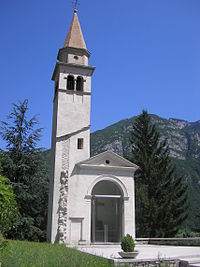Longarone
| Longarone | ||
|---|---|---|

|
|
|
| Country | Italy | |
| region | Veneto | |
| province | Belluno (BL) | |
| Local name | Łongaron | |
| Coordinates | 46 ° 16 ' N , 12 ° 18' E | |
| height | 474 m slm | |
| surface | 121.8 km² | |
| Residents | 5,180 (Dec. 31, 2019) | |
| Population density | 43 inhabitants / km² | |
| Post Code | 32013 | |
| prefix | 0437 | |
| ISTAT number | 025071 | |
| Website | www.longarone.net | |
 Longarone after reconstruction |
||
Longarone is an Italian commune with 5180 inhabitants (as of December 31, 2019) in the province of Belluno , Veneto region .
In the disaster of Vajont in 1963, almost all residents were killed by the consequences of a landslide in the reservoir at the Vajont dam above the community and the place was destroyed except for a church tower. This was followed by a partial new structure.
geography
Longarone is about 20 km north of the provincial capital Belluno , in the Piave valley . To the south of the town, the Torrente Maè flows from the west to the Val di Zoldo . From the east flows the Torrente Vajont , the damming of which led to the catastrophe.
The neighboring communities of Longarone are Belluno , Erto e Casso (PN), Forno di Zoldo , La Valle Agordina , Ospitale di Cadore , Ponte nelle Alpi , Sedico and Soverzene . The Dolomites high path 3 ends in Longarone .
history
Longarone is first mentioned in a document from 1190. It was one of the villages that line the middle course of the Piave River . The name is of geographical origin and comes from "Longoria", an ancient expression that describes a narrow piece of land along a river. The original civil and religious center was Pieve di Lavazzo, which, due to its protected location, has a history that goes back much further into the past.
The suburbs of Dogna and Provagna on the left bank of the Piave, Pirago and Fortogna on the right, were larger and more important settlements of today's center and have produced a higher number of historical finds. The oldest structures in this area are the bridge at Muda Maè and part of the road at Roggia .
In 1360 Longarone received its own small church, which was subsequently rebuilt and consecrated to St. Christopher . It was then used as a baptistery. There was a nursing home near the church. In the first half of the 15th century, Belluno and its surroundings became part of the Venetian Republic and Longarone became a commercial center. The first sawmills were built on the Piave. The forest became more and more important, so that the Serenissima took an interest in it.
At the beginning of the 18th century, wealthy workers, traders and administrators families began moving to Longarone, who set up their businesses here. The villas they built gave Longarone the architectural appearance of a splendid center of its time. Some of these villas only survived in memory, such as For example the Palazzo Sartori with its characteristic staircase or the Villa Stefani, later known as Villa Malcolm. Other villas are still standing, such as B. the Palazzo Mazzolà, today's seat of the town hall. The 18th century was the heyday of the city's artistic activities. The chasers Niccolò Cavalli, Pietro Gonzaga, painter and stage designer at the court of the tsar, and Caterino Mazzolà , who wrote the libretto for Mozart's opera La clemenza di Tito , among other things, come from Longarone .
In the 19th century, some residents took part in the uprising of northern Italy against the rule of the Habsburgs . One of them was Jacopo Tasso, who was executed by the Austrians in Treviso in 1849 and to whom there is a memorial in Longarone.
On October 9, 1963, the city was almost completely destroyed by the Vajont disaster . A single church tower remained and was preserved as a reminder of the accident. Almost all of the 2,000 inhabitants at that time fell victim to the accident.
The city was rebuilt in the 1960s and 1970s. Among other things, the modern church of Santa Maria Immacolata was built .
Every year in Longarone u. a. the “Mostra Internazionale del Gelato Artigianale” (International Ice Cream Fair ) takes place.
On February 21, 2014, Castellavazzo merged with the municipality of Longarone. The new parish kept the name Longarone.
Community partnerships
Longarone's partner communities are Bagni di Lucca in Tuscany and Urussanga in the Brazilian state of Santa Catarina .
See also
- Vajont (municipality, founded in 1971)
Web links
- Longarone Cultural Association
- Image Longarone before the disaster
- Image Longarone after the disaster
Individual evidence
- ↑ Statistiche demografiche ISTAT. Monthly population statistics of the Istituto Nazionale di Statistica , as of December 31 of 2019.
- ↑ Mostra del Gelato.com
- ^ Longarone website


